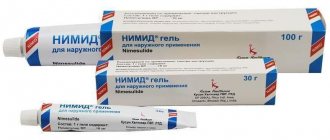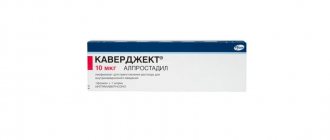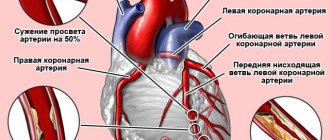Write a review
Reviews: 0
Manufacturers: Nycomed Danmark A/S
Active ingredients
- Not indicated. See instructions
Disease class
- Not indicated. See instructions
Clinical and pharmacological group
- Not indicated. See instructions
Pharmacological action
- Antidepressant
Pharmacological group
- Antidepressants
Release form and composition
Dosage form of Amitriptyline Nycomed:
- film-coated tablets (50 pieces each in dark glass bottles, 1 bottle in a cardboard box);
- film-coated tablets: white, biconvex, round (50 pieces in dark glass bottles, 1 bottle in a cardboard box).
Active substance contained in 1 film-coated tablet: amitriptyline – 10 or 25 mg.
Auxiliary components in 1 coated tablet: microcrystalline cellulose, polypropylene glycol, potato starch, magnesium stearate, lactose monohydrate, titanium dioxide, talc, methylhydroxypropylcellulose, corn starch, gelatin, croscarmellose sodium, polyvidone, purified water.
Auxiliary components in 1 film-coated tablet (10/25 mg):
- core: magnesium stearate – 0.25/0.5 mg; povidone – 0.83/0.6 mg; talc – 2.25/4.5 mg; microcrystalline cellulose – 9.5/18 mg; potato starch – 28.2/38 mg; lactose monohydrate – 27/40.2 mg;
- shell: propylene glycol – 0.2/0.3 mg; titanium dioxide – 0.8/0.9 mg; hypromellose – 1.2/1.4 mg; talc – 0.8/0.9 mg.
Analogs
Analogues of the drug amitriptyline nycomed are products containing Amitriptilin in their composition. For example, Amizol, Amirol, Elivel, Vero-Amitriptyline. All of the products listed are manufactured by different manufacturers. Medicines containing tricyclic antidepressants are sold in pharmacies strictly according to prescription.
Pharmacological properties
Pharmacodynamics
Amitriptyline Nycomed is a tricyclic antidepressant from the group of non-selective monoamine reuptake inhibitors. It has a pronounced thymoanaleptic and sedative effect.
The mechanism of action is associated with an increase in the content of serotonin and norepinephrine in the synaptic cleft in the central nervous system. The accumulation of these neurotransmitters occurs due to inhibition of their reuptake by the membranes of presynaptic neurons.
Amitriptyline is a blocker of alpha-1 adrenergic receptors, H1-histamine receptors, M1- and M2-muscarinic cholinergic receptors. Based on the so-called monoamine hypothesis, there is a correlation between the function of neurotransmitters at brain synapses and emotional tone.
A clear correlation between the plasma concentration of amitriptyline in the blood and the clinical effect has not been shown, but it is likely that the optimal clinical effect is achieved at a concentration of 100 to 260 μg/L.
Clinical relief of depression is achieved after 2–6 weeks of treatment (later than the equilibrium plasma concentration in the blood is achieved).
Amitriptyline Nycomed also has a quinidine-like effect on the innervation of the heart.
Pharmacokinetics
Amitriptyline after oral administration is completely and quickly absorbed from the gastrointestinal tract. Achievement of maximum concentration in blood plasma (Cmax) is observed within 2–6 hours after administration.
Plasma concentrations of amitriptyline in the blood of different patients may vary significantly. The bioavailability of amitriptyline is approximately 50%. About 95% of the substance binds to blood plasma proteins. The time to reach maximum concentration (Tmax) after oral administration is 4 hours, equilibrium concentration is approximately 7 days from the start of therapy. Volume of distribution is approximately 1085 l/kg. The substance crosses the placenta and is excreted in breast milk.
Metabolism occurs in the liver, with approximately 50% undergoing first-pass metabolism. In addition, amitriptyline undergoes N-demethylation by cytochrome P450 with the subsequent formation of an active metabolite, nortriptyline. The substance and its active metabolite undergo hydroxylation in the liver. N-hydroxy-, 10-hydroxy metabolite of amitriptyline, 10-hydroxynortriptyline also have activity. Amitriptyline and nortriptyline are conjugated with glucuronic acid (the conjugates are inactive). The main factor determining renal clearance and plasma concentration in the blood is the rate of hydroxylation. A small percentage of patients experience delayed hydroxylation (it is genetically determined). In the presence of impaired hepatic function, the half-life of amitriptyline/nortriptyline in the blood plasma is increased.
The half-life (T1/2) of amitriptyline from blood plasma ranges from 9 to 46 hours; nortriptyline – from 18 to 95 hours.
Excretion occurs mainly in the form of metabolites by the kidneys and through the intestines. Only a small part of the dose taken is excreted unchanged through the kidneys. In case of impaired renal function, the metabolism of amitriptyline and nortriptyline does not change, although their elimination is slowed down. Amitriptyline is not removed from blood plasma by dialysis (due to binding to blood proteins).
How it works?
Usually they choose Amitriptyline Nycomed for depression, neuropathy, and a number of other similar health disorders. Before choosing a drug, it is necessary to diagnose the person’s condition, including checking hormonal levels. The drug belongs to the group of tricyclic antidepressants. When the active component enters the body, it affects monoamines, since the drug does not selectively inhibit reuptake processes.
What are Amitriptyline Nycomed tablets for? Well, certainly not from a bad mood! This remedy has a pronounced sedative effect, but at the same time has a thymoanaleptic effect. Under its influence, the concentration of serotonin and norepinephrine increases in the body. This affects the functioning of the central nervous system, since the concentration changes in the synaptic cleft. Since the reuptake of compounds is blocked, their number increases over time.
Contraindications
Absolute:
- myocardial infarction (including recent ones);
- acute delirium;
- acute alcohol intoxication;
- acute intoxication with drugs with hypnotic, analgesic and psychotropic effects;
- angle-closure glaucoma;
- arrhythmias;
- intraventricular/atrioventricular conduction disorders;
- lactose intolerance, lactase deficiency and glucose-galactose malabsorption;
- prostatic hyperplasia with urinary retention;
- bradycardia;
- hypokalemia;
- paralytic ileus, pyloric stenosis;
- congenital long QT syndrome, as well as combination therapy with drugs that lead to prolongation of the QT interval;
- combination therapy with monoamine oxidase inhibitors, including a period of 14 days before starting use;
- age under 18 years;
- lactation period;
- individual intolerance to the components of the drug.
Relative (when prescribing Amitriptyline Nycomed, caution and medical supervision are required):
- diseases of the blood and cardiovascular system, including angina pectoris and arterial hypertension;
- acute angle of the chamber of the eye and flat anterior chamber of the eye;
- angle-closure glaucoma;
- increased intraocular pressure;
- urinary retention;
- prostatic hyperplasia;
- epilepsy (use of Amitriptyline Nycomed may lead to a decrease in the seizure threshold);
- convulsive conditions;
- hyperthyroidism;
- hypotension of the bladder;
- schizophrenia;
- bipolar disorder;
- liver or kidney dysfunction;
- chronic alcoholism;
- combination therapy with drugs with hypnotic and antipsychotic effects;
- pregnancy;
- elderly age.
When will it help?
All indications for Amitriptyline Nycomed are listed in the instructions for use of the drug. Prescribing it to yourself is strictly prohibited due to the possible negative effect on the body (the drug is potent). Admission is permissible if the medication is prescribed by a doctor indicating the reason (diagnosis), choice of dose and description of the dosage regimen.
Usually the drug is prescribed for depressive disorders that have endogenous causes, but it can also be used for other sources of severe emotional state. The drug can be used in the treatment of anxiety disorders. When choosing a drug, attention is paid not only to the specifics of the disease and the causes that provoked it, but also to the general condition of the patient and the specifics of the tests. At the same time, it is noted that if the instructions for use of Amitriptyline Nycomed are followed, the reviews from patients are generally positive, the condition actually gets better. The effect is most pronounced during the therapeutic course, but for many it remains stable even after completion of treatment. It is allowed to use "Amitriptyline Nycomed" for neuropathy.
Instructions for use of Amitriptyline Nycomed: method and dosage
Amitriptyline Nycomed 25 mg or 10 mg tablets are taken orally, preferably immediately after meals. The tablets should not be chewed.
Standard dosage regimen for adult patients: at the beginning of treatment - 25-50 mg in 2 doses, if necessary, the daily dose is gradually increased to 200 mg; duration of use – 6 months or longer (to prevent relapse).
The initial daily dose of Amitriptyline Nycomed for elderly patients is 25–30 mg in 1 dose (at night). If necessary, until the therapeutic effect is achieved, the dose is increased every other day to 50–10 mg per day. Prescribing a repeat course requires additional examination.
In case of liver failure, Amitriptyline Nycomed is prescribed in a reduced dose.
To avoid withdrawal symptoms (in the form of headaches, sleep disturbances, irritability and general poor health), the drug should be discontinued gradually. These symptoms are not a sign of drug dependence.
Reviews
Renat M .: “I had chronic pain after a leg injury. The doctor prescribed amitriptyline for pain and insomnia. The pharmacy offered to buy amitriptyline Nycomed. I didn't know what these pills were for, but the pharmacist said it was the same drug. I decided to consult a doctor, it turned out that this is indeed an analogue produced by Denmark. I took it once until the pills ran out, the other times I bought Russian analogues - they are cheaper. I didn’t notice any difference.”
Karina K .: “I have been undergoing treatment for anorexia for a long time. At first I was injected with antidepressants in the hospital until my weight was no longer critical. Then they discharged me home and prescribed the drug in tablets. I immediately started taking amitriptyline Nycomed, because I had taken various medications from this company before. I trust only trusted manufacturers.
Doctor's review : “Amitriptyline Nycomed is a good tricyclic antidepressant. The company Nikomed has established itself as a reliable and high-quality manufacturer of medicines. It is inconvenient for use in a hospital. It is difficult to control the intake of tablets that are in a bottle. You can always count them in a blister. But for use at home, we often recommend to patients a product from this particular company, since we know for sure that it does not produce so-called “dummies,” which is often found on the pharmaceutical market.”
Content
Side effects
Some of the following undesirable effects (in particular, tremor, headache, decreased sex drive and concentration, constipation) may be symptoms of depression, and they usually go away when the depression subsides.
More than 50% of patients may develop one or more of the following disorders while using Amitriptyline Nycomed. The drug may lead to the development of adverse reactions similar to those caused by other tricyclic antidepressants.
Possible adverse reactions (> 10% - very common; > 1% and < 10% - often; > 0.1% and < 1% - uncommon; > 0.01% and < 0.1% - rare; < 0. 01% – very rare):
- sense organs: very often - decreased visual acuity, impaired accommodation (reading glasses may be required during therapy); often – mydriasis; uncommon – increased intraocular pressure, tinnitus; rarely - worsening of narrow-angle glaucoma, loss of accommodation ability;
- skin: very often – hyperhidrosis; uncommon – urticaria, skin vasculitis, rash; rarely – alopecia, photosensitivity;
- urinary system: often – urinary retention;
- nervous system: very often – sedative effect (manifested in the form of lethargy, tendency to sleep), dizziness, tremor, headache; often – taste disturbance, decreased concentration, paresthesia, extrapyramidal symptoms (ataxia, akathisia, parkinsonism), tardive dyskinesia, dystonic reactions, slow speech; infrequently – convulsions;
- cardiovascular system: very often - tachycardia, palpitations, orthostatic hypotension; often - arrhythmia (including conduction disturbances, prolongation of the QT interval), hypotension, block of conduction along the bundle branches, AV block; uncommon – increased blood pressure; rarely - myocardial infarction;
- psyche: very often - disorientation, confusion (in elderly patients it manifests itself as anxiety, sleep disturbances, difficulty remembering, psychomotor agitation, confusion of thoughts, delirium); often - decreased concentration; infrequently - nightmares, manic syndrome, cognitive impairment, hypomania, mania, anxiety, fear, insomnia; rarely – delirium, aggressiveness, hallucinations (in patients with schizophrenia); very rarely - suicidal behavior/thoughts;
- reproductive system: very often – increased/weakened sexual desire; often (in men) – impotence, erectile dysfunction; rarely (in women) – delayed orgasm, galactorrhea, loss of the ability to achieve orgasm; rarely (in men) – delayed ejaculation, gynecomastia;
- digestive system: very often – constipation, dry mouth, nausea; often - inflammation of the oral cavity, gum recession, burning sensation in the mouth, dental caries; uncommon – vomiting, diarrhea, swelling of the tongue; rarely - cholestatic jaundice, paralytic intestinal obstruction, impaired liver function, swelling of the parotid gland, hepatitis;
- hematopoietic organs: rarely - thrombocytopenia, agranulocytosis, suppression of bone marrow functions, eosinophilia, leukopenia;
- laboratory indicators: often - widening of the QRS complex, prolongation of the QT interval, changes in the ECG; rarely - increased activity of transaminases and alkaline phosphatase, abnormal liver tests;
- metabolism: very often – weight gain, increased appetite; rarely – loss of appetite; very rarely - syndrome of inappropriate secretion of antidiuretic hormone;
- body as a whole: often – weakness; infrequently – swelling of the face; rarely – increase in body temperature.
Abrupt cessation of taking Amitriptyline Nycomed may cause the development of disorders such as nausea, malaise and headache. Gradual withdrawal of therapy is associated with the following transient symptoms (during the first two weeks of dose reduction): agitation, irritability, sleep and dream disturbances; in rare cases (within 2–7 days after cessation of long-term therapy) – hypomania, manic state.
Ending therapy: features of discontinuation
If you stop taking Amitriptyline Nycomed abruptly, there is a high probability of:
- headaches;
- general malaise;
- vomiting.
Doctors recommend discontinuing the drug gradually. At the same time, there is also a possibility of negative reactions from the body. As a rule, they accompany the first two weeks of withdrawal, when the dose of the active component entering the body is gradually reduced. Patients experience irritability, sleep may be disturbed, and others become overly excited. A manic state is very rarely recorded; there is a risk of developing hypomania. This is only possible after a very long course.
Overdose
Reactions to overdose vary significantly among different patients.
Moderate/severe intoxication in adults occurs when taking amitriptyline in a dose of more than 500 mg; taking about 1000 mg can be fatal.
The main symptoms of an overdose of Amitriptyline Nycomed may occur suddenly or develop gradually. In the first 2 hours, psychomotor agitation or drowsiness, hallucinations and symptoms are observed that are associated with the anticholinergic effect of the drug, in particular, convulsions, tachycardia, mydriasis, dry mucous membranes, urinary retention, weakened intestinal motility, increased body temperature. Then, impaired consciousness, respiratory failure, and severe depression of the functions of the central nervous system, progressing to coma, may occur.
Cardiac symptoms manifest as arrhythmia (ventricular tachyarrhythmia, fibrillation and ventricular flutter). Characteristic changes on the ECG are prolongation of the PR interval, widening of the QRS complex, depression of the ST segment, prolongation of the QT interval, inversion or flattening of the T wave and block of intracardiac conduction to varying degrees, which can lead to cardiac arrest. Heart failure, arterial hypotension, cardiogenic shock, metabolic acidosis and hypokalemia, confusion, anxiety, hallucinations and ataxia may occur.
Other symptoms:
- central nervous system: depression of its functions, convulsions, strong craving for sleep, coma;
- vascular system: hypotension;
- respiratory system: respiratory failure;
- psyche: hallucinations, psychomotor agitation;
- m-anticholinergic effects: muscle cramps, impaired accommodation, dry mouth, urinary retention.
In case of overdose, symptomatic and supportive therapy is indicated, including stopping taking Amitriptyline Nycomed, gastric lavage (even if some time has passed since taking the drug), and taking activated charcoal.
Even in seemingly uncomplicated cases, the patient's condition must be carefully monitored. It is necessary to monitor heart rate and breathing, level of consciousness, and blood pressure. The level of gases and electrolytes in the blood needs frequent monitoring. In order to prevent respiratory arrest, it is necessary to ensure airway patency and perform artificial ventilation.
ECG monitoring is carried out for 3–5 days. When the QRS complex widens, ventricular arrhythmias and heart failure, shifting the blood pH to the alkaline side (using sodium bicarbonate solution or hyperventilation) with rapid administration of a hypertonic sodium chloride solution (100–200 mmol Na+) can be effective. For ventricular arrhythmias, traditional antiarrhythmic drugs can be used, for example, intravenous lidocaine at a dose of 50–100 mg (1–1.5 mg/kg) followed by infusion at a rate of 1 to 3 mg/min.
If necessary, defibrillation and cardioversion are prescribed. Circulatory insufficiency can be corrected with the help of plasma replacement solutions, and in severe cases, dobutamine infusion is performed (initial dose - 2-3 mcg/kg/min; subsequently, depending on the effect, the dose can be increased). Convulsions and agitation can be controlled with diazepam.
Standard therapy is indicated for patients with metabolic acidosis. Dialysis is ineffective because the concentration of amitriptyline in the blood is low.
Prescribed intramuscularly or intravenously.
For severe depression resistant to therapy: intramuscularly or intravenously (administer slowly!) at a dose of 10-20-30 mg up to 4 times a day, the dose should be increased gradually, the maximum daily dose is 150 mg; after 1-2 weeks they switch to taking the drug orally. Children over 12 years of age and the elderly are given lower doses and increased more slowly.
When amitriptyline is used together with neuroleptics and/or anticholinergic drugs, a febrile temperature reaction and paralytic intestinal obstruction may occur. Amitriptyline potentiates the hypertensive effects of catecholamines, but inhibits the effects of drugs affecting the release of norepinephrine.
Amitriptyline may reduce the antihypertensive effect of sympatholytics (octadine, guanethidine and drugs with a similar mechanism of action).
When taking amitriptyline and cimetidine simultaneously, it is possible to increase the plasma concentration of amitriptyline.
Concomitant use of amitriptyline with MAO inhibitors can be fatal. The break in treatment between taking MAO inhibitors and tricyclic antidepressants should be at least 14 days!
special instructions
Before prescribing Amitriptyline Nycomed, blood pressure control is required (if the blood pressure is initially low/labile, it may drop even more).
When suddenly moving to a vertical position from a lying or sitting position, care must be taken, since during therapy there is an increased risk of bone fractures.
In some cases, hypokalemia or agranulocytosis may occur, and therefore it is recommended to monitor peripheral blood, especially with fever, tonsillitis and the appearance of flu-like symptoms. During long-term treatment, it is recommended to monitor the function of the liver and cardiovascular system.
You should not drink alcohol during therapy with Amitriptyline Nycomed.
Due to the m-anticholinergic effect of the drug, attacks of increased intraocular pressure, decreased tear production and a relative increase in the amount of mucus in the tear fluid may develop, which can cause damage to the corneal epithelium in patients wearing contact lenses.
There is information about a case of fatal arrhythmia that occurred 56 hours after an overdose of amitriptyline.
In suicidal patients, the risk of suicide may persist until depressive symptoms improve significantly. In this regard, during the first 2–4 weeks of using the drug, such patients need careful monitoring. The condition of patients who have previously had suicidal phenomena/expressed suicidal thoughts or have attempted to commit suicide before or during treatment requires constant medical supervision. Amitriptyline Nycomed must be given to them by a trusted person. It must be taken into account that the drug in persons under 24 years of age may itself increase the incidence of suicide, therefore, before prescribing it, it is necessary to assess the benefit/risk ratio.
In case of manic-depressive syndrome, taking the drug can provoke a manic phase, which requires its discontinuation.
Before surgery, Amitriptyline Nycomed should be discontinued if possible. During emergency operations, the anesthesiologist must be warned about the therapy being performed.
Amitriptyline Nycomed may affect the effect of insulin and changes in glucose concentration after meals. For patients with diabetes mellitus, adjustment of hypoglycemic therapy may be required. Depression can also affect glucose metabolism. When used in combination with other m-anticholinergic blockers, the m-anticholinergic effect of amitriptyline may be enhanced.
Dry mouth can lead to inflammation, changes in the oral mucosa, a burning sensation and dental caries. In this regard, it is necessary to notify the dentist about the treatment being carried out and undergo regular examinations.
Impact on the ability to drive vehicles and complex mechanisms
It is recommended to avoid driving vehicles while taking Amitriptyline Nycomed.
Indications
Amitriptyline Nycomed is used in the same cases as amitriptyline from other companies, with the exception of those when an injection form of the drug is required. Indications for its use are:
- Clinical depression and symptomatic decreased mood due to organic pathology;
- Anxiety and anxiety-phobic disorders;
- Schizoaffective disorder with a depressive component;
- Symptomatic insomnia;
- Bedwetting in children;
- Pain caused by any pathological condition;
- Psychogenic anorexia or bulimia.
Drug interactions
Suppression of the central nervous system by means of general anesthesia, anticonvulsants, antipsychotics, hypnotics and sedatives, narcotic/central analgesics, and alcohol is potentiated by taking Amitriptyline Nycomed. Amitriptyline, like other tricyclic antidepressants, is metabolized by the hepatic cytochrome P450 isoenzyme CYP2D6, which has several isoforms in humans.
The CYP2D6 isoenzyme can be inhibited by various psychotropic drugs, in particular, antipsychotics, serotonin reuptake inhibitors (excluding citalopram, which is a very weak inhibitor), the latest generation antiarrhythmic drugs (phenytoin, procainamide, esmolol, amiodarone, propafenone) and P-blockers.
These drugs can inhibit the metabolism of Amitriptyline Nycomed and significantly increase its concentration in the blood plasma. The isoenzymes CYP3A and CYP2C19 are also involved in the metabolism of amitriptyline.
Contraindicated combination - with monoamine oxidase inhibitors: development of serotonin syndrome, including spasms during excitement, myoclonus, coma, delirium. You can start therapy with monoamine oxidase inhibitors 2 weeks after stopping amitriptyline; you can start taking Amitriptyline Nycomed 2 weeks after stopping the irreversible, non-selective monoamine oxidase inhibitor and 24 hours after stopping the reversible inhibitor moclobemide. In any case, treatment with these drugs should be started with small doses, gradually increasing them depending on the effect.
Not recommended combinations with Amitriptyline Nycomed:
- clonidine, methyldopa: weakening of their hypotensive effect;
- adrenaline, ephedrine, isoprenaline, norepinephrine, dopamine, phenylephedrine, used, for example, for general/local anesthesia or in the form of nasal drops: enhancing their effect on the cardiovascular system;
- drugs that can prolong the QT interval, including H1-histamine receptor blockers (for example, terfenadine), antiarrhythmic drugs (quinidine, etc.), some antipsychotics (especially sertindole, pimozide), anesthetics (isoflurane, droperidol), sotalol, chloral hydrate: increase risk of developing ventricular arrhythmia;
- phenothiazine derivatives, antiparkinsonian drugs, H1-histamine receptor blockers, atropine, biperiden: enhancing their effect on the central nervous system, visual organs, bladder and intestines; increased likelihood of intestinal obstruction and a strong increase in body temperature;
- lithium salts: increased toxicity of lithium, which manifests itself in the form of tremor, tonic-clonic seizures, difficulty remembering, mismatch of thinking, hallucinations, neuroleptic malignant syndrome;
- fluconazole, terbinafine: increased serum concentration of amitriptyline in the blood and increased associated toxicity; possible fainting, ventricular fibrillation/flutter.
Combinations that require caution:
- barbiturates and other inducers of microsomal liver enzymes, including carbamazepine, rifampicin: increased metabolism of amitriptyline and a decrease in its plasma concentration in the blood, which leads to a weakening of the antidepressant effect of Amitriptyline Nycomed;
- drugs that depress the central nervous system, including drugs with hypnotic and sedative effects, strong analgesics, alcohol: increased inhibition of the functions of the central nervous system caused by their use;
- neuroleptics: mutual inhibition of metabolism; this may cause a decrease in the seizure threshold and the development of seizures (dose adjustment may be required); combination with sleeping pills (droperidol) requires extreme caution;
- methylphenidate, cimetidine, slow calcium channel blockers: increased plasma concentrations of amitriptyline in the blood, which may result in increased toxicity;
- valproic acid: decreased plasma clearance of amitriptyline, which may lead to an increase in its concentration, including the concentration of nortriptyline (metabolite); when used in combination, monitoring of these indicators is required (a dose adjustment of Amitriptyline Nycomed may be required);
- sucralfate: weakening of absorption of amitriptyline and its antidepressant effect;
- preparations of St. John's wort: decrease in the maximum concentration of amitriptyline in the blood plasma (a dose adjustment of Amitriptyline Nycomed may be required);
- phenytoin: inhibition of its metabolism, increasing the likelihood of its toxic effects (tremor, hyperreflexia, ataxia, nystagmus); at the beginning of therapy, patients receiving phenytoin need to monitor its concentration; it is necessary to monitor the therapeutic effect of Amitriptyline Nycomed, since an increase in its dose may be required.
Alternative options
The price of Amitriptyline Nycomed is low, one package costs about 45-50 rubles and contains 50 tablets. And yet, in some cases, patients who were prescribed the drug are interested in what it can be replaced with. This is usually due to either intolerance to additional components, or the desire to choose a drug that provokes fewer negative effects during long-term use.
The most common analogues of Amitriptyline Nycomed:
- "Amitriptyline";
- "Saroten retard";
- "Amitriptyline Zentiva."
The replacement must be agreed upon with the attending physician. Changing the drug to any other antidepressant on your own is strictly prohibited.





